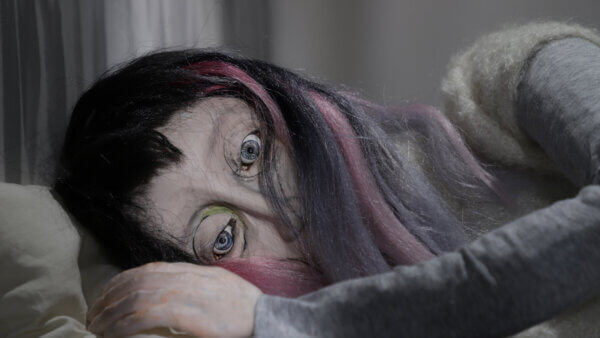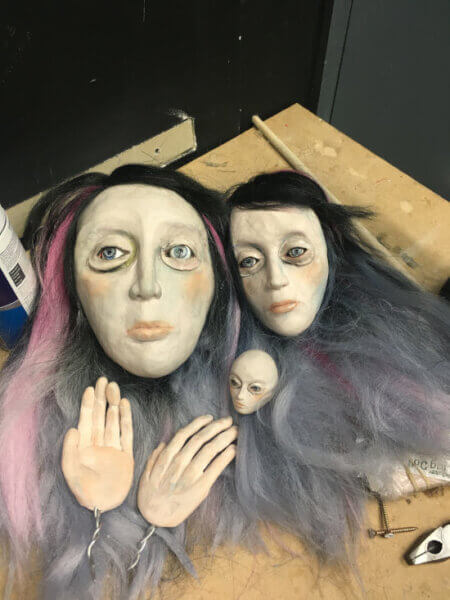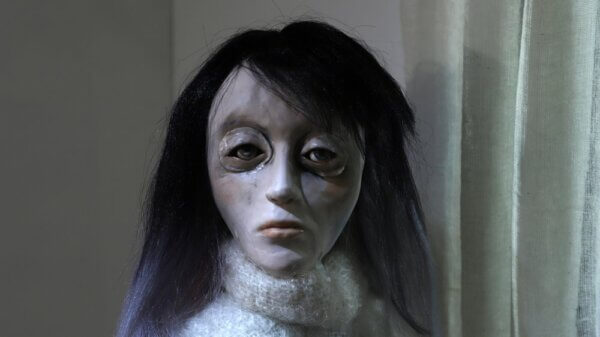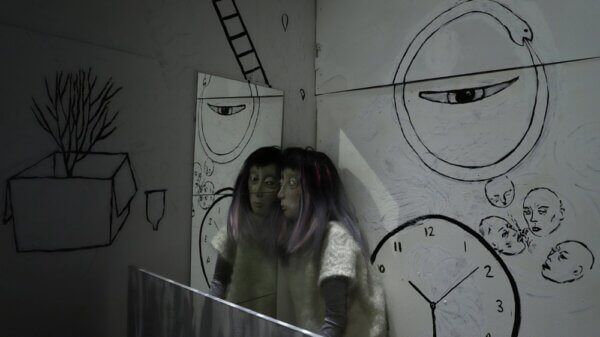Interview with Ali Aschman, director of ‘Shadow Passage’
Shadow Passage is the newest film by mixed-media artist and filmmaker Ali Aschman, a recent graduate from the Royal College of Art’s MA Animation programme. Her new film brings together complex ideas of self, represented by multiple scaled puppets and the rooms they inhabit. Combining 2D painted animation on the walls of the room with large scale puppets make for an impressive visual that portrays an intimate account of the filmmaker’s inner psyche; ss the characters discover and comfort one another the filmmaker discovers more about herself. Shadow Passage is a film that deals with uncertainty, fear and bravery, as its characters submit to the unknown beyond the final door, itself a metaphor for life’s journey.
With much uncertainty around the current festival situation, Ali has brought forward the online release of the film and recently posted it online in full, quickly earning a Vimeo Staff Pick. Skwigly spoke with Ali to discuss her process, influences and future plans in uncertain times.
As a visual artist who works in many mediums and disciplines, how did you come to work in animation?
I was in an MFA programme at the School of the Art Institute of Chicago back in 2011-2013, and I was working mainly with installation, printmaking and paper-cutting at the time. As part of the degree, I could take any of the hundreds of studio classes, in any department, which was exciting to me because my Bachelor’s degree was from a small Fine Art programme with few resources so I didn’t have the opportunity to try as many things as I would have liked. One of my graduate advisors in my first semester suggested I experiment with moving image because my work was so narrative-based yet frustrating in how little of the story it gave away in a single image. So I signed up for a puppet animation class and really loved it! I began my first ever film, The Thief, in that class. Looking back at it now, it’s painfully naive, but it was a seminal change my practice at the time. During that time I also met Chris Sullivan, a professor at SAIC who is an incredible 2D and multi-plane animation filmmaker, and working with him as my advisor, teacher and friend solidified that this was a good medium for my ideas and talents. I’ve always preferred processes that require patience and attention to detail. Since then, I’ve continued making films alongside a drawing and sculpture practice, though since moving to London for the RCA I’ve been making animation almost exclusively. I like to combine some of these disciplines, such as with my film ‘Body Echo’ where I made the puppets and sets from porcelain, which I had worked with previously in my sculptural work. Or in my earlier films Elsewhere, the Survivors and The Wrong Story I used etching, silkscreen and woodcut to print the paper elements.
Your work has a brooding, dark, poetic and almost otherworldly quality, how would you define your aesthetic and what key figures or influences do you feel have impacted your work?
In addition to how you’ve described it (which I like), some words I would use to define my aesthetic are handmade, tactile, detailed, surreal, uncanny, melancholy and introspective. Some major animation influences are the Quay Brothers, Cristóbal León and Joaquín Cociña, Janie Geiser and Allison Schulnik. TOOL music videos were what made me fall in love with stop motion as a teenager, even though I didn’t start doing it myself for another decade. Likewise, growing up in South Africa I loved William Kentridge and I still think he’s pushing the medium in incredible ways through interdisciplinary practice, though I wouldn’t say he’s much of an influence on my own style. Visual art influences include Robyn O’Neil, Kiki Smith, Louise Bourgeouis, Annette Messager, among many, many more. I tend to be drawn to work that is figurative, mysterious, theatrical, made with a high level of craft and care, and that leaves me feeling a little uneasy.

Shadow Passage (Dir. Ali Aschman, RCA)
Your most recent film Shadow Passage was your final film from the Royal College of Art’s MA programme, how did your time there impact your work and what did the course, tutors and fellow filmmakers bring to the experience?
My experience at the RCA was a mixed one. It’s a fantastic course, though it has the same problems the rest of the college is facing as it expands in student numbers without quite matching expansion of resources, due to government funding cuts. The tutors are great, I only wish the structure allowed for a more sustained relationship between tutors and students. We had some excellent workshops that deepened my understanding of writing, directing, editing, sound and cinematography, introduced me to pitching and working with production timelines, and many that were just good fun even when they didn’t feed directly into a film project. And of course, it was fantastic to be around so many talented artists and animators, both for peer-learning and inspiration as well as just having a lovely social group. Everyone was very unpretentious which was honestly a nice change from the art world. The RCA helped to connect me with my composer and sound designer for my first-year film Body Echo, as they were both MA students at the Royal College of Music and the National Film and Television School respectively, and I loved working with them so much we collaborated again on Shadow Passage. So those were all positive things. On the other hand, being on the course at a much later stage in life to the majority of students, with less animation-specific education and knowing absolutely nothing from an industry standpoint, caused me a huge amount of anxiety and self-doubt, which was occasionally so paralysing I couldn’t do any work at all. I got through it in the end though! And all the soul-searching I did feedback into the content of my films, so it was generative as well as painful.
Watching the behind-the-scenes footage I can see the impressive scale you worked at to create the three different versions of the character, what considerations were made to work in these varying sizes?
I came up with the idea of rooms reducing in size quite early on and was initially thinking of having five or more rooms. Then I set about building them based on what was possible considering the size of the studio, combined with the dimensions of the largest pieces of free wood I could find lurking around the college campus! I would have loved for the first room to actually be life-size and the last to be teeny-tiny, but unfortunately, that wasn’t possible due to space, budget and time. As the year went on I realised it was best to whittle down to three rooms, for both practical and conceptual reasons, and I adjusted the sets and puppets accordingly. At the time I made that decision I had only made the wire armatures for the puppets so it wasn’t too much work wasted. I wanted them to be different enough in scale to make it clear that was a significant element of the story, to show an increasingly cramped space, especially in the last room, conveying a sense of confinement within the self. My costume designers had a fun time making identical outfits at different scales, and even made a matching top for me to wear! We should really do a photo shoot.

Image courtesy of Ali Aschman
You mention on your website that your work is often involved self-portraits; the title of the film comes from the Jungian model of the psyche. Does each of the scaled puppets represent aspects of you or the ideas at the centre of the film? If so, is the scale of each puppet representative of a hierarchy you place on these aspects?
Yes, they are all aspects of myself. In the most simplistic terms, the first puppet is the critical part which is logical and intellectually-driven and tends to overthink. The second puppet is the sad emotional part that bursts forth sometimes, lacks reason and is very difficult to control. The third puppet is the spirit, or perhaps the inner child. She’s not very playful but rather small and scared, hiding behind the door. But in the end, she takes the brave step to pass through the door into the unknown.

Shadow Passage (Dir. Ali Aschman, RCA)
It’s not a hierarchy of importance, but they do appear in the order I feel they are layered within myself. The critical aspect is like a persona, it’s the face I present to the world and also the way I tend to think of myself in ideological terms. The emotional part is a part of the shadow for me, a part of myself I prefer to deny, though honestly, it doesn’t take a whole lot for it to come to the surface. Say, a few pints and a lack of sleep. And the spirit is the most deeply buried – I’m still discovering that part of me and it’s definitely not on show for the world, though everything stems outwards from there and it informs the other layers. When these three parts of myself are at odds with one another, things don’t go well, but if I can acknowledge and be kind to all of them, it creates a space for healing and growth.
Most of your other films include a spoken voice, how do you decide what does and doesn’t require narration in your films?
Aside from The Thief, my earlier films are less linear and more like collages, and the voice is another layer in addition to the visual and aural elements. It is more atmospheric. Then with First Kiss, I made a deliberate attempt to tell a story through word and image, though the text is doing most of the work. Because the subject matter is a memory of real events, this made sense, and I had a teenager narrate it so that it would feel like it was in the present moment, with certain lines spoken by me as they come from a place of looking back. With Body Echo, the voiceover serves to take one out of the narrative a bit – since with puppets one usually expects a story, and though there is one in the film it’s more like a dream or a thought, so the narrator is addressing the character in the second person, telling her things, rather than narrating a story. For Shadow Passage, I wanted to take a break from my usual way of working and push myself out of my comfort zone, and regarding voice that meant either having a dialogue between the puppets, or no words at all, letting the image, music and sound design do all the work. As the film took the form it didn’t seem like I needed dialogue – since they are all aspects of oneself they don’t need to speak. I was thinking about it more like a dance piece than like a play.
The film, like most of your work, brings together various elements including stop-motion, projection and 2D elements painted directly on to the walls of the sets. Were there any strategies put in place to manage all of these aspects?
I wish! I could probably have been more organised about it. But the short answer is no, I just did it, one frame at a time. There were a few days when I had someone helping me on set, doing the camera moves or focus pulls and triggering the Dragonframe remote, so I could just move the puppet or paint on the walls, and then it went much quicker than doing it all alone. If I use projection again, I’d like to do more with it, such as animating the puppet or images at the same time as the projected image changing or having a puppet interact with a projected animation of itself.

Shadow Passage (Dir. Ali Aschman, RCA)
I’ve read in previous interviews that you don’t storyboard or create animatics for your films before production, which must give you a sense of freedom often not found in animation. Why do you choose to work in this way and what benefits do you think it brings to your work and you as the creator?
I think it’s just the way my brain works. When I make sculptures or installations I don’t make sketches first either, I prefer to just dive right in. This process has its drawbacks too, but I feel the benefit to me as a creator is a constant excitement as I continuously discover the work while it takes shape. Each decision or accident leads to the next idea.
What is next for both the film and yourself?
The film supposed to screen at a few more festivals later this year that have been postponed due to COVID-19, and I’m also still sending it out. I hope I will get to travel with it a little more after festivals begin to happen in real life again, but I’m not counting on that, which is why I decided to put it online permanently after it was in Flatpack Festival’s online edition.
What’s next for me? I’m dealing with a lot of uncertainty just like everyone else right now, as I had two major freelance projects cancelled. So I’m spending more time drawing, watching other people’s films, researching ideas and applying for grants and commissions. I’m trying to do some 2D animation too, which I’m less comfortable with, but I’m not sure yet what that will turn into. Hopefully something I can show publicly, but if not, experimentation for its own sake is good too!
You can see mroe of Ali Aschman’s work at aliaschman.com.

